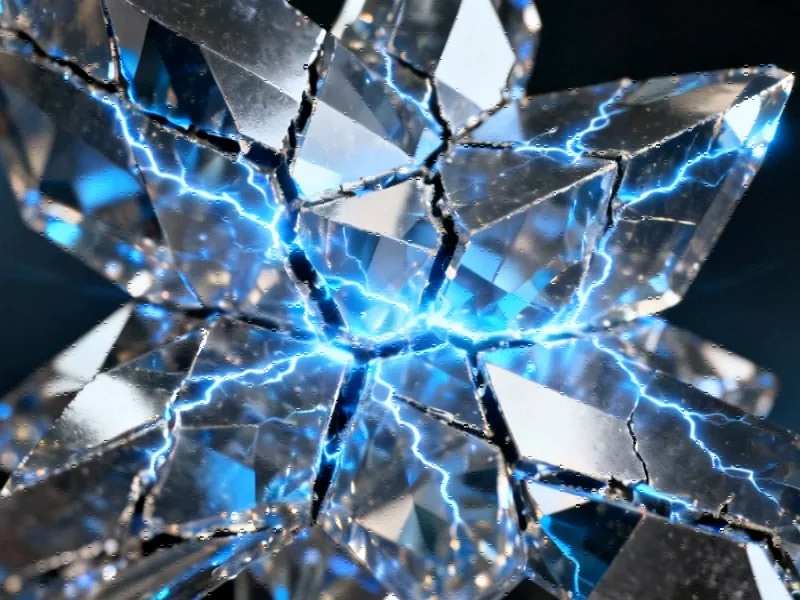Crystal Engineering Unlocks Low-Pressure Solid-State Battery Performance
Researchers have made a significant advancement in solid-state battery technology by demonstrating how cathode crystal orientation controls mechanical stress generation during operation. According to reports published in Nature Communications, this discovery enables lithium metal solid-state batteries to function effectively at stack pressures below 5 megapascals – dramatically lower than the 60+ MPa typically required.
The Critical Role of Crystallographic Orientation
The study focused on lithium cobalt oxide (LCO) cathodes with different crystallographic orientations. Sources indicate that cathodes with (110) planes parallel to the substrate, designated N-LCO, generate negative (tensile) stress during charging, while those with (003) planes parallel, called P-LCO, produce positive (compressive) stress. The report states this stress difference stems from the anisotropic nature of lithium diffusion, where (110) planes serve as good lithium-ion conductors while (003) planes are largely impermeable.
Analysts suggest this fundamental understanding of mass diffusivity variations by crystal orientation explains why N-LCO cathodes demonstrated superior performance under low-pressure conditions. The three-fold stress magnitude difference between orientations directly impacts battery longevity and safety.
Stress Management Through Microstructural Engineering
Researchers developed three distinct cathode microstructures – P-LCO, Z-LCO, and N-LCO – with controlled grain orientations relative to the substrate. According to the analysis, N-LCO generated approximately -30 kPa stress during charging, while P-LCO produced +40 kPa stress, representing a complete reversal in chemomechanical response. Z-LCO showed near-zero stress generation at approximately 5 kPa.
The report states that texture coefficients calculated from X-ray diffraction data confirmed the (003) contribution was 70 times larger in P-LCO compared to N-LCO, while the (110) contribution was more than twice as large in N-LCO. This precise control over crystal orientation enabled researchers to systematically study stress effects on battery performance.
Critical Current Density Breakthroughs
Under low stack pressure conditions of 1 MPa, N-LCO cells demonstrated surprising resilience against failure modes, according to the findings. While Z-LCO and P-LCO showed voiding events at current densities exceeding 1 mA/cm², N-LCO cells maintained operation without short-circuiting or void formation even at high current densities.
The study implemented full-cell critical current density tests, which analysts suggest provide more realistic assessment than symmetric cells because they capture the asymmetry in chemomechanical behavior between negative and positive electrodes. This testing approach reflects broader industry developments in battery validation methodologies.
Mechanistic Insights Through Electrochemical Analysis
Electrochemical impedance spectroscopy revealed distinct behaviors between cathode types. According to reports, P-LCO cells showed irreversible increases in bulk resistance at higher C-rates, indicating loss of electronic pathways and void formation. In contrast, N-LCO maintained stable bulk resistance even under fast charging conditions of 4C (4.8 mA/cm²).
Researchers observed an intriguing “healing” phenomenon in P-LCO cells where voids formed during low-rate discharge were reversed during charging, thanks to the compressive stress behavior. However, beyond certain current density thresholds, this reversibility was lost, leading to permanent degradation. These findings highlight the complex chemical kinetics at play in solid-state interfaces.
Practical Implications for Battery Manufacturing
The ability to operate lithium metal solid-state batteries at pressures below 5 MPa addresses a major commercialization barrier. Conventional solid-state batteries typically require stack pressures exceeding 60 MPa, complicating battery pack design and increasing costs. This advancement could influence market trends in electric vehicle adoption.
Sources indicate that the research demonstrates how cathode engineering can mitigate interface degradation mechanisms without requiring complex external pressure systems. The findings come amid broader related innovations in materials science and energy storage. By controlling intrinsic material properties rather than relying on external constraints, this approach represents a paradigm shift in solid-state battery design that could accelerate commercialization timelines.
This article aggregates information from publicly available sources. All trademarks and copyrights belong to their respective owners.
Note: Featured image is for illustrative purposes only and does not represent any specific product, service, or entity mentioned in this article.



